Driving the Electric Revolution Engage with...Webinar Highlights

Innovate UK KTN has hosted over 50 'Engage with…' webinars to support the Driving the Electric Revolution challenge, and this article outlines some of the key highlights from this webinar series.
Introduction
Throughout the Covid-19 lockdowns in 2020 and 2021, Innovate UK KTN has organised weekly Engage with… webinars to support the Driving the Electric Revolution challenge. In this article, we outline and provide a summary of some of our highlights from the dozens of Engage with…webinars that have taken place over the last few years.
About the Engage with… Webinars
The webinars have promoted company abilities to the wider ‘Driving the Electric Revolution’ community and have resulted in new introductions and an increased level of networking. They have also identified possible areas of collaboration for funding and have provided solutions and answers to challenges.
The webinars are held to promote an organisation’s PEMD (Power Electronics, Machines and Drives) Supply Chain ability/capability, to build a community around PEMD technologies that can foster collaborations among companies who can assist each other, and to help expand knowledge of available resources, build supply chains, and improve networks. Presenters are asked not just to promote their abilities and capabilities, but also to discuss how they are currently planning to, and are able to begin, engaging with others. The audience is predominantly technically-focused engineers who are interested in the PEMD development to catalyse green innovation and bring about net zero.
Engage with… 2022 Events
Innovate UK KTN is hosting a variety of Engage with… events over the next few months. Make sure to register for our flagship face-to-face event Engage with…Live in Sheffield on 29th March 2022!
Click here for details of our other upcoming Engage with… webinars and recordings of previous events.
Engage with...Webinar Highlights
When we Engaged with… Rolls-Royce
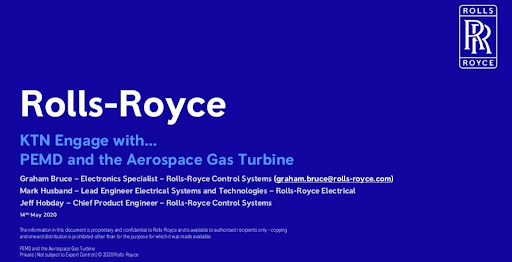
View the Rolls-Royce presentation slides here.
This webinar featured speakers from Rolls-Royce and focused on PEMD and the Aerospace Gas Turbine. Taking place on 14 May 2020, in this article we summarise and outline the key points from that presentation and a catch-up meeting with the speakers. The purpose of this article is to discover how the webinar enabled other Power Electronics, Machines and Drives (PEMD) supply chain organisations to network with Rolls-Royce, and to pursue the aim of being a catalyst for green innovation and to help enable routes to Net Zero.
Rolls-Royce believes in the transformational potential of technology. Their focus is on pioneering the power that matters for the needs of tomorrow as well as today. Within the aerospace industry, there is a strong pull to accelerate electrification in both civilian and defence markets. PEMD is a key enabler for a ‘more-electric’ gas turbine and is also an enabler for longer-term opportunities in electric flight at varying scales. In the webinar, Rolls-Royce provided an insight into the specific challenges associated with designing and deploying PEMD solutions within the harsh environment of a gas turbine, from which the company hoped to seed future partnerships within the UK supply chain.
Speakers from Rolls-Royce Control Systems who presented ‘PEMD and the Aerospace Gas Turbine’ were:
- Graham Bruce – Power Electronics Specialist
- Mark Husband – Lead Engineer Electrical Systems and Technologies
- Jeff Hobday – Chief Product Engineer
They discussed the move to a ‘more-electric’ gas turbine, with a focus on the use of Power Electronics in a Solid State Gearbox, and the key challenges of improving power density through a combination of appropriate system-level design optimised packaging and component optimisation.
To enable a ‘more-electric’ gas turbine, reliability is a key focus, with the following characteristics:
- The assumed reliability of mechanical items is 1 x 10-6 failure per flying hour.
- No single point fault can cause a loss of thrust control.
- Electrical and electronic solutions must be fault-tolerant.
To move to a ‘more-electric’ turbine it was highlighted that the electrification of components must provide a significant performance or operability improvement. An example might be whether a gear pump could be made to last longer while still fulfilling its requirements during operation on an aircraft.
In summary, the speakers concluded that PEMD is an essential ingredient, and offers an amazing opportunity to shape the future of aerospace. However significant challenges exist in deploying PEMD solutions on an aerospace gas turbine that would meet all the key requirements, including reliability and availability, environmental ruggedness, and performance.
The future for PEMD solutions for incremental ‘more-electric’ and disruptive opportunities in aerospace will build upon the existing aerospace experience and exploit ongoing developments in other sectors.
When we Engaged with... RNLI
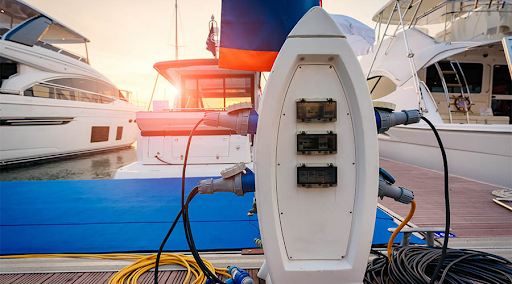
View the RNLI webinar recording here.
In this webinar, the Royal National Lifeboat Institution (RNLI) joined us to present the Implications and Practicalities of Electrification of RNLI’s Marine-based Emergency Service. Victoria Limbrick, Energy & Environmental Resources Manager, RNLI, and John Newell, Chair of RNLI Technical Committee presented at this webinar.
The webinar was held on 20 May 2021, and in this article, we highlight the key points from that presentation and the catch up with the speakers we had to discover how the webinar had enabled other PEMD supply chain organisations to network with RNLI and to pursue the aim of being a catalyst for green innovation and to help enable routes to Net Zero.
The RNLI is working to address the current and future implications and practicalities of electrification of their marine-based emergency services. The RNLI has committed to eliminating or reducing its negative impacts on the environment, and to becoming a low-carbon, zero-waste-to-landfill, and climate-resilient organisation in the future.
The fuel used for lifeboats, rescue watercraft, and vehicles accounts for around 57% of the RNLI’s total energy use, with the other 43% being accounted for by the gas and electricity to power its buildings and equipment. With its ambition to be a ‘zero carbon from road transport’ organisation by 2040 and increasing usage of renewable energy sources for their buildings, the focus then becomes the fuel for the marine fleet.
A detailed description of the RNLI’s strategy for fuel efficiency is on its website. The implications and practicalities of electrification in the context of marine-based emergency services are challenging, and it is typically not yet practicable to implement with current technologies. The RNLI is therefore actively monitoring and assessing future marine propulsion and engine developments that could eventually enable them to move away from fossil fuels to a low- or zero-carbon alternative: this would be central to achieving RNLI’s ambition to be Zero Carbon by 2050.
In this webinar, the RNLI explained how it is in the relatively unique position of being in control of in-house maritime engineering, with design and build taking place in its own factories. Coupled with owning the operation, maintenance, and disposal of the fleet, this provides RNLI with a whole life perspective for managing trials and collaboration towards the electrification of marine-based emergency services.
The practicalities of electrification of the RNLI’s Marine-based Emergency Service were highlighted during its webinar. A key consideration is that any future marine vessels must meet stringent operational requirements, which include being able to:
- Launch within 10 minutes of being notified
- Operate up to 100 nautical miles out to sea
- Reach at least 90% of all casualties within 10 nautical miles of the coast, within 30 minutes of launch – in any weather
These conditions are further constrained by:
- Unpredictable operations
- Variable and unpredictable conditions (typically the sea and the weather)
- Towing and/or standby requirements
- Repeat call-outs
- Remote Lifeboat stations and lifeguarded beaches
In summary, the RNLI’s marine fleet comprises 297 inshore lifeboats, 106 all-weather lifeboats (with around a further 80 in production). With an ambition to achieve Zero Carbon status by 2050, the RNLI is looking for partners to help it review, assess and develop future alternative propulsion projects. The scope of the partnerships would include:
- Trials and collaboration
- A review of technological opportunities and limitations
- Evaluation of potential operational alterations that could facilitate change
When we Engaged with… Electrified Automation
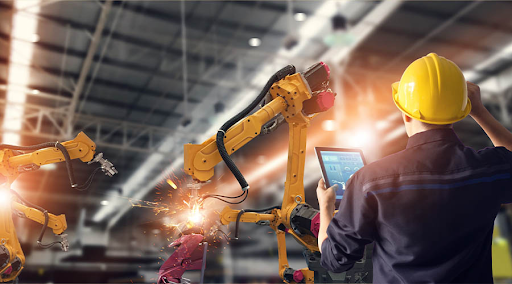
View this Electrified Automation webinar recording here.
In this webinar, we were joined by Electrified Automation who presented on how Electrified Automation are applying their processes in e-machine manufacturing, and how they are building a UK PEMD supply chain to support them. Held on 18 March 2021, Jim Winchester (Managing Director) and Lloyd Ash (Founder & Innovation Director) gave excellent presentations.
The mission of Electrified Automation is to ‘drive the world towards electrification through their people, ideas and actions by means of process development, automation equipment, e-machine components, and value chain software. The company provides automated processes and assembly lines to enable the fabrication of motors that will be critical to the use of PEMD in supply chain development and the route to Net Zero.
Electrified Automation is a manufacturing automation company that designs and supplies production lines for companies that have challenges in scaling up production. It develops improved manufacturing processes for electric motors – for example, better methods for handling and winding copper, and for assembling copper windings.
Electrified Automation is working with organisations globally to apply its expertise and IP in e-machine manufacturing to a range of motor topologies and end-user markets. A series of manufacturing processes and associated automated equipment have been developed, ranging from coil winding through to rotor assembly, to enable its customers to accelerate their plans for electrification.
The presentations focused on concentrated coil windings, which have a direct requirement for use in motors and in PEMD applications. The production of coil windings presents challenges to manufacturing companies regarding flexibility in their available equipment, as well as the cost of acquiring in-house capability, and from a practical point of view in addressing factors such as ‘copper fill’.
Electrified Automation described how they have developed concentrated coil windings for motors, improved wire jointing, and insulation, and developed new production stator moulding processes – with significantly improved takt times – and also processes for motor magnet placement.
Electrified Automation’s IP and the patent portfolio have comprehensive coverage of all motor sizes, applications, and industries, from off-road vehicles through to large industrial applications. The technology they have developed to improve manufacturing automation is applicable to all markets, but particularly those requiring the production of motors with a high power density.
The presenters discussed the current gap in capabilities and the opportunities in the UK e-machine supply chain. This gap is currently focused on the motor stators – with an identified shortage of stator manufacture, winding equipment, and stator moulding – all of which Electrified Automation has experience in.
Regarding collaboration, Electrified Automation is currently working with local companies to increase the recyclability and reuse of motor materials at end of life. This will include future work planned to improve the designs of motors to assist in their de-construction after use. The speakers also highlighted that they are looking for engagement and partnerships for e-machine production.
When we Engaged with... Paragraf
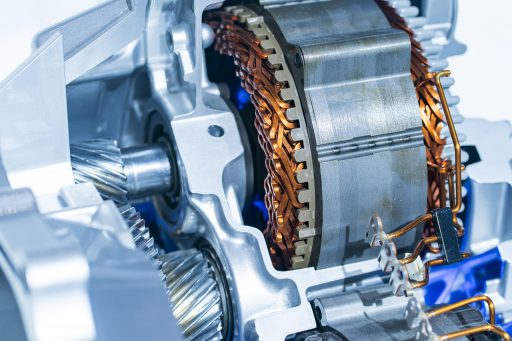
View this Paragraf webinar recording here.
On 4 February 2021, Paragraf presented to an audience of 80 people online about how the company delivers commercial-quality graphene electronic devices for the battery, sensor, green energy, and semiconductor markets.
Presented by Dr Ellie Galanis (Product Owner, Graphene Hall Sensors) and Dr Ivor Guiney (Technical Director), the webinar outlined how Paragraf has created a proprietary process for depositing single-atom thick, two-dimensional materials that include graphene, directly onto silicon, silicon-carbide, sapphire, gallium-nitride, and other semiconductor-compatible substrates. The contamination-free technology is scalable and is compatible with existing electronic device manufacturing processes.
During the webinar, Paragraf demonstrated how it has developed and delivered graphene electronic devices at commercial quality and scale, initially in the form of graphene Hall Effect sensors. It uses standard large scale, volume manufacturing semiconductor device production toolsets to produce wafer-scale graphene products in a format that can be incorporated into the electronics device manufacturing chain.
Hall Effect sensors are commonly used for sensing position, velocity, or directional movement, and have the advantage of contactless operation, which means that they are low maintenance, and are also resistant to vibration, dust, and water. Hall Effect devices are conventionally based on a compound semiconductor material such as gallium arsenide (GaAs). When the device is placed in a magnetic field, a small voltage – called the Hall Voltage – is induced in the semiconductor element, which is proportional to the strength of the magnetic field passing through it. Hall Effect sensors are ideal for automotive applications and are widely used in car engines and anti-lock braking systems (ABS). They are, however, susceptible to various possible faults, such as flaws in the core (like corrosion, cracks, residual magnetic fields, and core breakage), changes in the bias current, or changes in the magnetic properties of the ferrite core due to temperature variations. The induced magnetic field in the sensor can also change polarity due to various factors including mechanical shock. The properties of the semiconductor material in Hall Effect sensors can exhibit considerable temperature drift, regardless of the manufacturer.
Paragraf’s process introduces the unique properties of graphene into magnetic field sensing applications. Graphene is well suited as a Hall Effect magnetic sensor material due to its high carrier mobility and two-dimensional nature. Its low carrier concentration gives it the advantage of high sensitivity and thus a wide field measurement range. Unlike conventional Hall Effect devices, amplification is not required, and graphene’s inherent strength and resistance to both thermal and electrical shock makes it robust and gives it a wide operating temperature range.
Paragraf’s R&D team is now working on the industrial exploitation of their graphene sensors. Key application areas include: measurement and control; engine monitoring and optimisation; electric motor speed and position control; and energy cell and energy bank analysis.
At the end of the webinar, several questions were posed by the audience, including the following:
- Is the graphene sensor sensitive to levels of moisture or other gaseous substances within the package cavity?
- For newcomers to incorporate any type of graphene technology into their systems, what would Paragraf judge to be the main aspects to consider?
- Are there any requirements for periodic recalibration of the Hall Effect sensor?
- Particularly in respect of motor applications, how sensitive is it to noise?
- Does the quality of graphite used to impact the overall quality of the graphene, and in turn the performance of the final products?
The conclusion was that Paragraf produces wafer-scale, transfer-free, contamination-free graphene devices that are compatible with industry-standard semiconductor substrates, in a format that can integrate directly with existing semiconductor production toolsets. At its own custom facility, Paragraf is now making graphene sensors and semiconductor devices at scale. With its graphene Hall Effect sensors, Paragraf is currently the only company in the world with a graphene electronic device in production and on the market.
When we Engaged with… Lincoln Institute for Agri-Food Technology
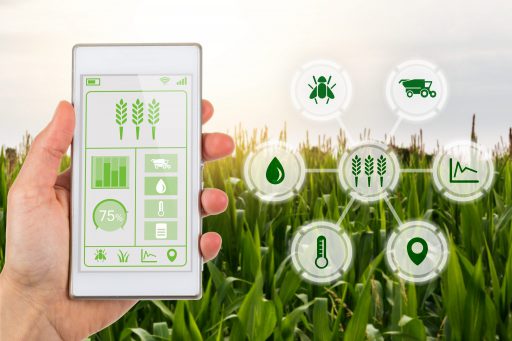
View the Lincoln Institute for Agri-Food Technology presentation slides here.
Lincoln Institute for Agri-Food Technology webinar, held on 2nd July 2020, highlighted opportunities for the UK manufacturing sector to engage in this transformation of the food production system. Professor Simon Pearson of the Lincoln Institute for Agri-Food Technology described the Institute and its activities, along with its capability in relation to the broad portfolio of active projects that they are engaged with. He then outlined future opportunities for collaboration with the industry.
The University of Lincoln is one of the UK’s leading developers of agri-robotic technologies. The Lincoln Institute for Agri-Food Technology specialises in robotic systems to support autonomous crop harvesting and the electrification of farming. Their goals include supporting and enhancing the future of food and agriculture productivity, efficiency, and sustainability through research, education, and technology.
It has become crucial to implement these technologies urgently post-Covid-19, particularly as UK farmers are currently facing a labour shortage, at the same time as a growing UK population and the requirement to meet net zero targets are further increasing the pressures on the agricultural sector. Robotic systems could reduce reliance on manual labour and improve yield. Furthermore, farming currently has a high dependency on off-road – typically diesel-powered – vehicles, and it needs to move away from carbon-based fuel systems. The agricultural sector, therefore, has both a requirement and an opportunity to transition to robotic electric powered vehicles; this may involve a move towards smaller fleets of lightweight electric-powered vehicles or larger machines.
During the online presentation, Simon highlighted the palpable concern from the agri-sector about the issues it anticipates and key solutions being considered including the focus on the automation of crop picking (agri-robotics), which is expected to be able to make an impact on agriculture in the very near term.
The development of agri-robotic technologies requires multi-disciplinary development that expands outside the Driving the Electric Revolution’s core focus on Power Electronics, Drives, and Machines (PEMD). To help enable this, the Lincoln Institute for Agri-Food Technology brings together sector-leading expertise across a diverse range of disciplines, including motors, electronics, artificial intelligence, robotics, engineering, crop science, environmental sustainability, food manufacturing, product development, and supply chains.
Concluding the event, Professor Pearson highlighted that although the Accelerated Automation programme has demonstrated that the UK has multiple high TRL robotic projects, there is an urgent need to support industrial design and scaling, with a focus on ‘robotics’ rather than ‘engineering’. He also questioned if the electrification of agriculture might need a complete rethink of agricultural machinery and methods, with an example being ‘How long will we keep using “conventional” tractors?’.
At the end of the webinar, the 93 attendees asked over 30 questions, bringing it to a very interesting conclusion. Following the event several organisations requested a formal introduction to the Lincoln Institute for Agri-Food Technology, to explore whether there was potential for collaborative work between them.
Directly following on from this Engage With…, a consortium was formed to develop an Integrated E-hub for agritech applications. This was motivated by the problem that current electric drives available for use in agritech are expensive and unreliable, as they are based on either e-bike motors at small capacity or automotive drive units at high capacity. The consortium, therefore, set itself the objective of developing and proving a fully-integrated single box drive (motor controller, motor, gearbox & park brake) with the correct speed, torque, and durability to match agritech applications.
The consortium is led by Performance Projects Ltd (mechanical design/driveline product), along with Printed Motor Works (electromagnetic components), University of Lincoln (Simulation, R&D and field trials), Saga (0.8kW vehicle requirement), and ARWAC (8kW requirement). Together they have successfully designed, manufactured, and installed onto vehicles the proof-of-concept fully-integrated units rated at both 0.8kW and 8kW, and are now commencing a programme of dyno and field trials. The project has led to the formation of OxDrive, a joint venture between the owners of Performance Projects and Printed Motors, which specialises in e-hub manufacture for agritech, and associated off-highway markets including construction and defence.
More Information
Find out more about the Driving the Electric Revolution challenge by clicking here.
To arrange a meeting to discuss the Driving the Electric Revolution challenge, please feel free to contact Sven Knowles, Knowledge Transfer Manager for Electronic Systems at Innovate UK KTN, or Paul Huggett, Acting Head of Industrial Technologies and Manufacturing at Innovate UK KTN.
Related Content
Related Opportunities
Driving the Electric Revolution: Building Talent for the Future 2
Opens: 10/01/2022 Closes: 02/02/2022
Innovate UK’s Driving the Electric Revolution challenge, part of UK Research and Innovation, will invest up to £4.5 million in projects to create and deliver course content and materials that will support skills, talent and training across Power Electronics, Machines and Drives (PEMD) manufacturi


